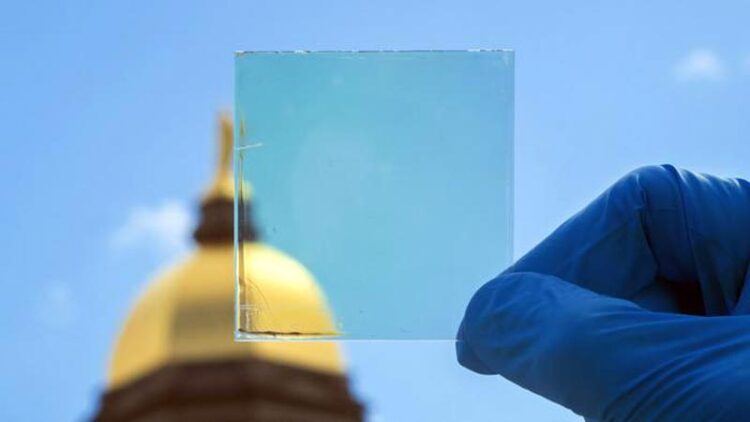Sunrise to sunset, new window coating blocks heat — not view

Researchers at the University of Notre Dame have developed a new window coating to block heat-generating ultraviolet and infrared light and allow for visible light, regardless of the sun’s angle.
Credit: University of Notre Dame
Windows welcome light into interior spaces, but they also bring in unwanted heat. A new window coating blocks heat-generating ultraviolet and infrared light and lets through visible light, regardless of the sun’s angle. The coating can be incorporated onto existing windows or automobiles and can reduce air-conditioning cooling costs by more than one-third in hot climates.
“The angle between the sunshine and your window is always changing,” said Tengfei Luo, the Dorini Family Professor for Energy Studies at the University of Notre Dame and the lead of the study. “Our coating maintains functionality and efficiency whatever the sun’s position in the sky.”
Window coatings used in many recent studies are optimized for light that enters a room at a 90-degree angle. Yet at noon, often the hottest time of the day, the sun’s rays enter vertically installed windows at oblique angles.
Luo and his postdoctoral associate Seongmin Kim previously fabricated a transparent window coating by stacking ultra-thin layers of silica, alumina and titanium oxide on a glass base. A micrometer-thick silicon polymer was added to enhance the structure’s cooling power by reflecting thermal radiation through the atmospheric window and into outer space.
Additional optimization of the order of the layers was necessary to ensure the coating would accommodate multiple angles of solar light. However, a trial-and-error approach was not practical, given the immense number of possible combinations, Luo said.
To shuffle the layers into an optimal configuration — one that maximized the transmission of visible light while minimizing the passage of heat-producing wavelengths — the team used quantum computing, or more specifically, quantum annealing, and validated their results experimentally.
Their model produced a coating that both maintained transparency and reduced temperature by 5.4 to 7.2 degrees Celsius in a model room, even when light was transmitted in a broad range of angles. The lab’s results were recently published in Cell Reports Physical Science.
“Like polarized sunglasses, our coating lessens the intensity of incoming light, but, unlike sunglasses, our coating remains clear and effective even when you tilt it at different angles,” Luo said.
The active learning and quantum computing scheme developed to create this coating can be used to design of a broad range of materials with complex properties.
Journal: Cell Reports Physical Science
DOI: 10.1016/j.xcrp.2024.101847
Article Title: Wide-Angle Spectral Filter for Energy-Saving Windows Designed by Quantum Annealing-Enhanced Active Learning
Article Publication Date: 4-Mar-2024
Media Contact
Jessica Sieff
University of Notre Dame
jsieff@nd.edu
Office: 574-210-4554
All latest news from the category: Physics and Astronomy
This area deals with the fundamental laws and building blocks of nature and how they interact, the properties and the behavior of matter, and research into space and time and their structures.
innovations-report provides in-depth reports and articles on subjects such as astrophysics, laser technologies, nuclear, quantum, particle and solid-state physics, nanotechnologies, planetary research and findings (Mars, Venus) and developments related to the Hubble Telescope.
Newest articles

Self-Destructing Cancer Cells: Cutting-Edge RNA Breakthrough
Jülich scientists use novel RNA technology to selectively switch off tumours in the brain. An Adaptable Platform Technology That Destroys Glioblastoma Cancer Cells Using a special RNA molecule, a team…

Endurance Training: Transforming Lives of Heart Failure Patients
Can strength and endurance training be beneficial for patients with a certain form of heart failure? A research team from Greifswald investigated this question together with seven other research centers…

A Wake-Up Call for Mediterranean Shark Protection Against Extinction
Overfishing, illegal fishing and increasing marketing of shark meat pose significant threats to the more than 80 species of sharks and rays that inhabit the Mediterranean Sea, according to a…



